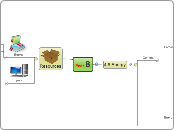jonka peter hill 15 vuotta sitten
1131
Year 8
Course contents and docs for year 8

jonka peter hill 15 vuotta sitten
1131

Lisää tämän kaltaisia
TaskA: Students independently devise and design a first hand investigation that enables an understanding of the concept of friction as a force.
friction video, friction lesson
friction and sliding block, friction applet
TaskB: Students perform teacher-prepared first hand investigations and explain their observations in terms of the Electric Lines of Force Model eg balloons, water, electroscopes etc
Students evaluate the advantages and disadvantages of this model.
electric field lines, electric fields
First hand investigations using magnets and electromagnets. Complementary assessment task.
Task: Students research the significance of the Law of Gravitation as an explanation of the motion and characteristics of celestial objects.
Gravity and Gravitation, Gravitation applet
Task: Students identify different forms of energy and devise/design models to describe the phenomena.
Task: Students design and perform first hand investigations and label summative diagrams showing energy transfers in simple series and parallel circuits.
construct dc circuits
sound waves
em waves (radio), electromagnetic waves
em simple theory
simple theory heat transfer
Experimental investigations in conduction, convection and radiation
Task: students research and identify technological applications of sound, light and heat transfer
Students research the origin of the Law of Conservation of Energy and its significance to the Physical Sciences.
applet Conservation of Mechanical Energy
Bridges, trebuchets etc
Conservation
1d) qualitatively account for the total energy involved in energy transfers and transformations
Transfers
3a) associate electricity with energy transfer in a simple circuit
3b) construct and draw circuits to show transfer of energy.
4a) describe sound as a form of energy requiring a medium for propagation.
5a) describe light as a form of energy not requiring a medium for propagation.
6a) identify processes of heat transfer by conduction, convection and radiation.
Definition
1a) identify situations or phenomena in which different forms of energy are evident
1b) use models to describe different forms of energy
1c) identify objects that possess energy because of their motion (kinetic) or because of other properties (potential)
Gravity
Magnetism
Electrostatic
Ideas
8a) describe ways in which objects acquire an electrostatic charge
2b) use the term ‘field’ in describing forces acting at a distance.
7c) describe the behaviour of charges when they are brought close to each other
Example
7b) identify everyday situations where the effects of electrostatic forces can be observed
Class Exp
Muscle
History
Friction
7a) describe friction as a contact force which opposes motion
7b) identify everyday situations where friction acts.
What they do
2a) identify changes that take place when particular forces are acting
Balanced Deform
Unbalanced Accelerate